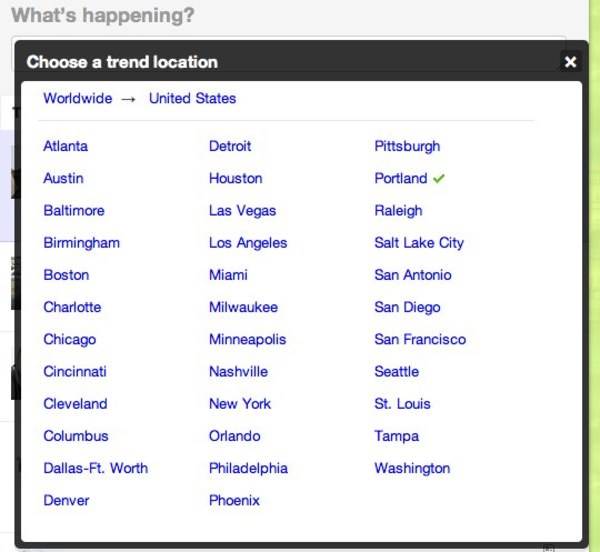Twitter announced this afternoon that the Local Trends feature it announced in 41 cities and countries in January, 2010 has now expanded to 70 more places. Trending local topics are an easy way to discover people and conversations outside your own personal niche. The band Rise Against is playing in my town tonight, for example, and I probably wouldn’t have noticed it had I not checked what’s popular in Portland.

This near-tripling of venues for the consideration of what’s hot seems likely to foreshadow a future when advertisers will be able to purchase trending topics on a local level. A more logical step, though, would be to try to fix the problems with location on Twitter. There’s clearly something wrong with it as so few people append locations to their Tweets. Check out the screenshot below for some idea why.

Unfortunately, use of location data on Twitter has been generally disappointing. When geotagging Tweets first began 18 months ago, we wrote a wide-eyed article titled What Twitter’s New Geolocation Makes Possible. Twitter platform lead Ryan Sarver favorited my Tweet to that article – he liked it. Little has come of it, though. We hear from data wonks that a very low percentage of Tweets have location data associated with them. One study a year ago concluded that only 0.5% of all Tweets are geotagged. Twitter says of that report “we don’t comment on third party reports.” When asked how the location of Tweets are determined, if they need to be geotagged, the company said only “We use a variety of factors to determine Tweet location.”
Twitter hasn’t done a very good job of communicating with users about just how specific the locations associated with their messages will be or why they should geotag their Tweets. I almost never let Twitter know my location, in large part because I did once from home and the map in the official Twitter app pointed directly at my house. I just tried it again and sure enough, that’s my damn house. Who wants to mess around with that?

Right: Click on that map and you can see a Google Street View picture of my front door, with a map showing the exact location of the basement I’m sitting in. It may be my mom’s basement and I may be in pajamas, but that’s none of your business, Twitter.
Local trends are sure to be a source of entertainment for users, none the less, and they may prove valuable for marketers.
Frank Reed wrote last January on Marketing Pilgrim that this kind of geographic segmentation could be helpful to marketers in general, not just those relative few today who advertise on Twitter itself. “As a tool for marketers it could do great things for research for various geographic groups,” he wrote. “Understanding the ‘vibe’ of an area could even help in crafting messaging for paid search ads that are being served to that area. Of course, this will not be something that affects businesses universally but it certainly could help the right kind of business.”
We asked Twitter if today’s expansion of Local Trends portends a roll out of more granular advertising options but haven’t received a response yet.





















